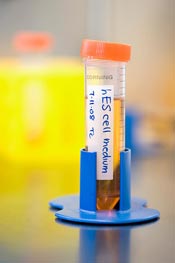New $8.9 million project aims to unlock stem cell secrets
Although scientists have had access to human embryonic stem cells for a decade, precisely how the all-purpose cell gives rise to all other cells in the body and why others do not remains a fundamental mystery of biology.
But now, with the help of an $8.9 million grant from the National Institute of General Medical Sciences (NIGMS), a team of researchers from the University of Wisconsin–Madison will embark on a quest over the next five years to tease out the secrets of stem cells’ ability to morph into all of the cell types that make up the body.
“The basic theme (of the award) is pluripotency and reprogramming,” explains James Thomson, a UW–Madison School of Medicine and Public Health professor of anatomy, director of regenerative biology at the new Morgridge Institute for Research and one of the leaders of the new effort. “How do cells decide to exit a pluripotent state and become a certain cell type, and how, when reprogrammed, does a differentiated cell go back to a pluripotent state?”
The new Wisconsin project is one of three announced today (Aug. 4, 2008) by NIGMS, one of the National Institutes of Health.
“The Wisconsin team will conduct cutting-edge research to address some of the most fundamental questions about stem cells,” notes Marion Zatz, who oversees stem cell grants at NIGMS. “The project promises to advance the field of stem cell research by revealing new information about the protein modifications necessary for gene expression during stem cell differentiation while developing innovative technologies for studying the basic properties of stem cells.”
The new Wisconsin project involves an interdisciplinary team that brings together researchers from chemistry, the UW School of Medicine and Public Health, the Wisconsin National Primate Research Center, the Genome Center of Wisconsin, the Morgridge Institute for Research, and the Medical College of Wisconsin. The three projects embedded in the overall research program supported by the new grant include:
- Assessing chemical change in histones, key proteins responsible for compacting and packaging DNA into chromosomes. Using new mass spectrometry methods, a team led by UW–Madison chemistry Assistant Professor Josh Coon will attempt to detail histone changes as embryonic stem cells change from an undifferentiated cell to a cell of a specific type.
- To see how stem cells exit their blank-slate state to become specialized types of cells, a group led by Thomson will detail chemical changes that occur as stem cells are exposed to growth factors.
- Using proteins found in embryonic stem cells, a group led by blood expert Igor Slukvin and Genome Center scientist Junying Yu will explore how the proteins, which act like genetic switches, can reprogram blood cells to a pluripotent state.
In addition, the grant will support a core services program, directed by Coon and chemistry Professor Lloyd Smith, to further develop mass spectrometry methods to assess in detail chemical changes that occur during development.
“Mass spectrometry is a tool to help us identify proteins and changes in proteins so we can see what molecular signals are present and how they are turned on or off as cells go through differentiation,” says Smith.
The core program will also help build and refine techniques for large-scale embryonic stem cell culture. Studying the proteins made by stem cells and their interactions requires large quantities of cells, Smith notes. “Now, growing large numbers of stem cells is hard and expensive,” and having cheaper and more efficient methods of culturing cells is necessary, he adds.
Tags: biosciences, stem cells





